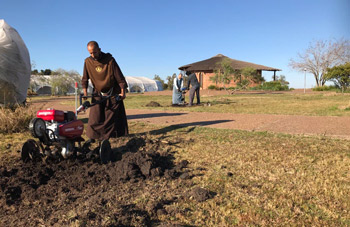Project of afforestation of the Light-Community
Project of afforestation of the Light-Community
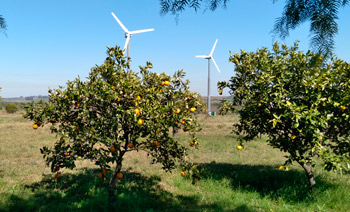
With the purchase of the fields to form what now is the Light-Community Fraternity of Aurora, several species of trees were planted. This year broader planning of planting fruit trees and other species for the self-sustainability and reforestation of the Light-Community has begun.
The meadows and isolated forests are the distinctive biomes of the region of Paysandu, Uruguay, and are part of the natural landscape of the Light-Community. As the trees in the areas were monocultures of orange trees and other species in a dispersed manner, this new project aims to increase the biodiversity of the zone and help to regenerate the soil through polycultures.
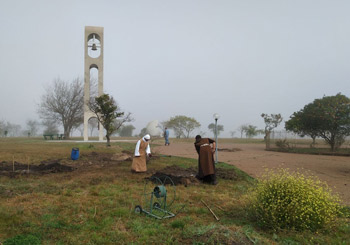
The afforestation project designed for the three areas involves several stages. The first stages are crucial for the proper development of the project because the clay soil, which is poor in nutrients, does not allow the trees to develop well.
Currently, a first experience has already begun. It is the planting of a reduced number of trees among all the members of the group of plantations, thus covering the maintenance needs of the trees.
"Although the need is high and we intend to have many fruit trees, we only got 103 trees as a first impulse. We feel that this is what we can take care of since their care is very demanding," says Friar Akhbar, a member of the plantations sector.
He adds: "The idea was to make this first experience to give the trees the best possible care and see how they respond, so that, based on this, in the coming years we can increase the number of fruit trees and other species to create a greater biodiversity."
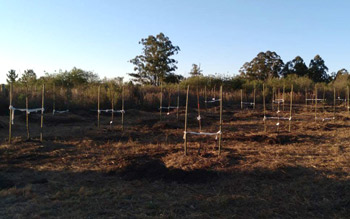
As a first stage, we chose the areas to carry out this first experience.
In the Redemption 1 area, the selected region is the Marian Center. In the Redemption 3 area, it is an area where there are already fruit trees.
In the Redemption 2 area, the chosen place is located within the agroforestry system, next to a future lake, because it is a strategic place for the correct interaction between the trees and the plantations. We named this place: "Bosque Elohim" (Elohim Forest).
In the next stage, we began to dig the wells. First, using well-digging machines and then manually. We fertilized each well carefully with dung, compost, sand, basalt, phosphorite, and ash, elements that help provide the necessary nutrients for the plants.
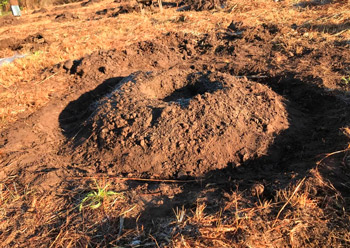
Strategically, we placed more soil at the tree base and straw around the tree to prevent the organic matter put in the well from sinking and causing water drainage problems. Thus, we ensure proper water retention in the area.
Friar Akhbar explains: "The most time-consuming part of the project is to dig the wells and let them settle. By the beginning of September, we managed to complete 50% of the project. In the upcoming group work, the following steps will be to fill in the remaining wells with organic matter and then plant some 50 or 60 remaining trees during the spring.
It must be during the spring because in Uruguay summers are hot, so we risk that the plant will not develop properly."
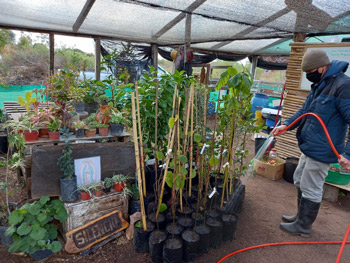
There were already many aged orange trees, some of them sick when we purchased Redemption 1 area. Since we could not recover them, it was necessary to remove them to plant new trees.
"When we purchased Redemption 1 field, it was a monoculture of orange trees, so the soil is now poor in nutrients. We are trying to regenerate the area by planting, in addition to orange trees, other species of trees. We will take advantage of the momentum to create more shady areas," says Sister Maria de la Contemplación, a member of this project.
In addition to the plantation, we are placing special emphasis on caring for the existing trees by means of pruning, treating wounds and soil, and protecting them from frost.
Among the species that we acquired are citrus trees such as oranges (Citrus sinensis), tangerines (Citrus reticulata), lemons (Citrus limon), grapefruit (Citrus paradisi).
We also acquired fig trees (Ficus carica), plum trees (Prunus domestica), olive trees (Olea europaea), Surinam cherry trees (Eugenia uniflora), and walnut trees (Juglans regia), among others.
"As spring is beginning, we only planted the deciduous trees, those that have no leaves, because they are planted in winter. They have already started to sprout very well and have had a good growth response," explains Friar Akhbar.
All members of the Group of Plantations are taking care of the trees according to the climate, depending on the rainfall and the humidity of the environment. A rhythm of natural fertilization will also be created by means of the compost and other liquid products produced in the Light-Community.
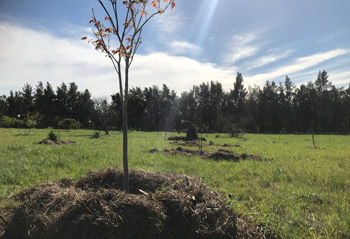
The idea is to follow a schedule to cover the needs of all the trees.
Sister Maria de la Contemplación comments that since the beginning of the project, it was good learning of awareness since the group must feel what the Kingdoms of Nature need.
This led to paying more attention to the rhythms of nature, serving another living being, and being grateful for all that they provide to the other Kingdoms.
"One thing you work on is service and selflessness. When you plant a tree, it will take years to grow, so you are aware that you are planting for others, for the planet and future generations, and not for yourself," says the sister.

And Friar Akhbar adds: "I feel that the project is a milestone for the Light-Community. It will establish contact by seeing the fruits grow and harvesting them. It creates a connection and gratitude for life and nature.
As they are fruit trees, the project aims at a self-sustainable life, towards a sustainable future, and the experience will help us learn how to do large-scale projects."

